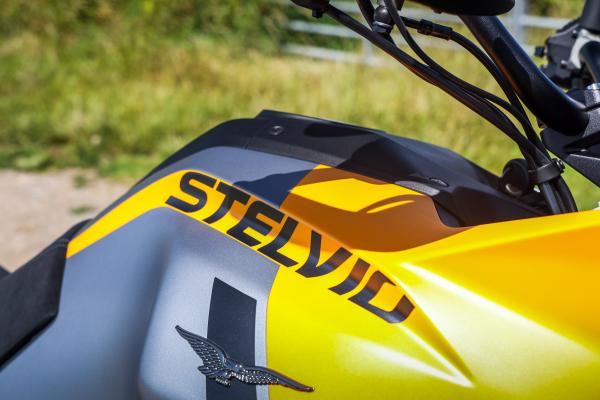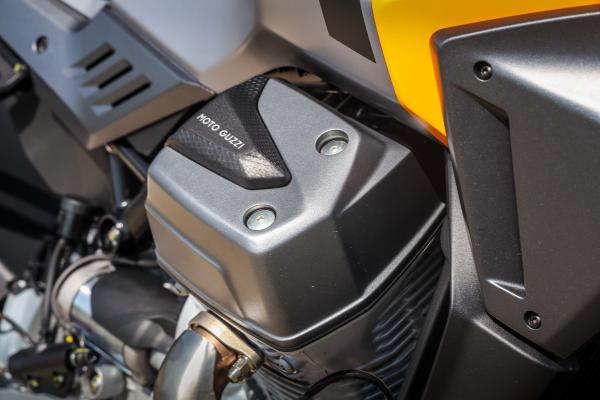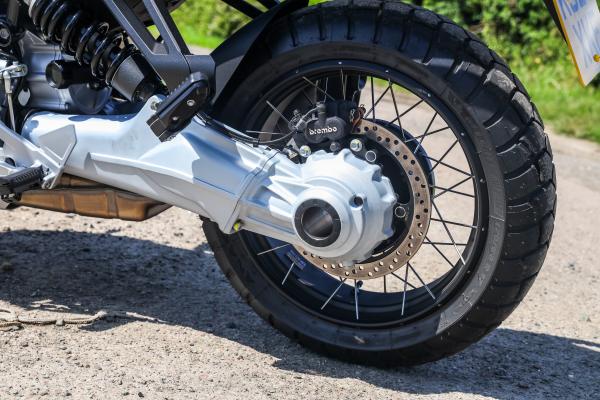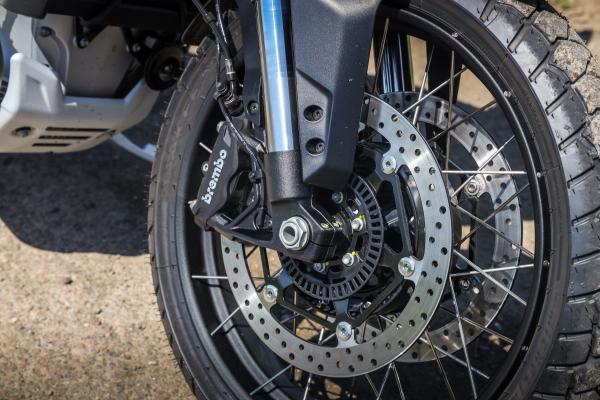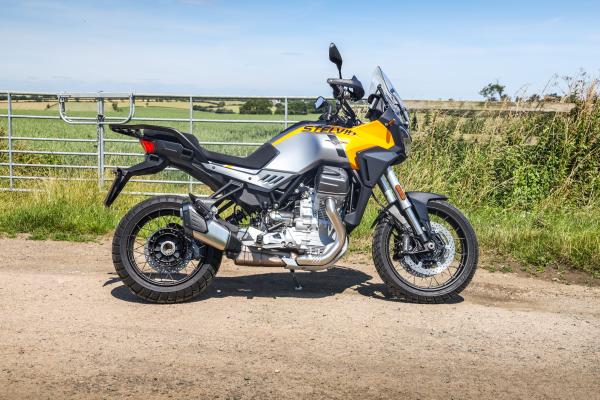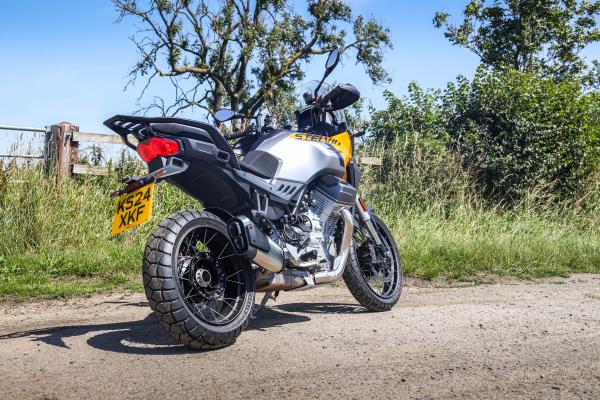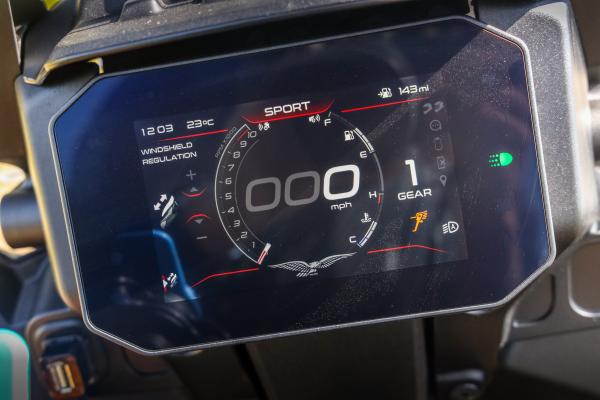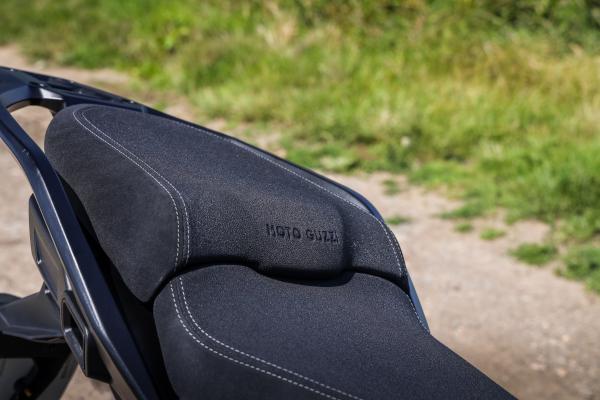Moto Guzzi Stelvio Review: Character Without Compromise?
The Stelvio is more interesting than the average middleweight ADV but competes with the best on relatively equal terms

Member for
54 years 8 monthsAs far as a USP goes, a longitudinally mounted V-twin takes some beating. It means that the Moto Guzzi Stelvio is instantly recognisable as a bike from the Lake Como-based brand just from the sight of its cylinder heads poking out from each side of the bike.
There’s something joyful about having the odd glance down and seeing those Moto Guzzi-branded rocker covers proudly on display just in front of your legs. It’s a wonderfully quirky detail that helps the Stelvio stand out in the busy middleweight ADV segment, but how does the rest of the bike measure up?
We rode the Stelvio on a variety of roads, keeping it on the tarmac (where the bike is mostly intended for) during the week that we had it.
Moto Guzzi Stelvio engine, frame, chassis and technology
There’s a reason the Stelvio might look familiar to you, both aesthetically and in terms of its spec. That’s because the bike owes much to the V100 Mandello, taking the bones of that bike but going in more of an adventure-bike sort of direction.
We say ‘sort of direction’ as this isn’t some trail-smashing beast, as evidenced by Moto Guzzi only bumping the front wheel up to 19 inches and shodding both it and the 17-inch rear in 80 per cent road/20 per cent trail Michelin Anakee Adventure tyres. Oh, and then there’s the name - the bike gets its name from the Stelvio Pass in Italy, a mountain road very much coated in asphalt.
Because it was developed in tandem with the related Mandello, the Stelvio benefits from an all-new steel frame and a fresh 1,042cc engine. It’s a liquid-cooled lump, robbing it of one of the benefits of the longitudinal placement (having air-cooled cylinder heads so exposed is great for keeping things at a nice temperature), but no matter, as it features some clever engineering to remove one of the not-so-great aspects of the configuration.
Normally, by mounting the crankshaft along the length of the bike, you get what Moto Guzzi refers to as “overturning torque,” an unwanted rolling reaction when accelerating or decelerating. To combat this, there’s now a counter-rotating crankshaft which is also smaller and lighter than the old 1200 engine. Interia, meanwhile, has been reduced by 50 per cent.
113bhp at 8,700rpm and 87lb ft of torque at 6,750rpm make their way rearwards via a single-sided swingarm and - another unique aspect of the Stelvio - shaft drive. No other middleweight ADV has this. If it’s a must-have for you, there’s no choice but to splurge more on something bigger like a Triumph Tiger 1200 or BMW R1300 GS.
The engine works with a six-axis IMU, giving cornering ABS, four levels of traction control and five riding modes: Tourism, Rain, Street, Sport, and Off-Road. Going for the PFF (Piaggio Fast Forward) version of the bike adds a suite of safety features including forward collision warning, adaptive cruise control, blind spot information system and lane change assist.
In terms of the chassis, there’s a 46mm Sachs upside-down fork working with a KYB monoshock at the rear, with each providing 170mm of travel (compared to 130mm in the V100 Mandello) and allowing for preload/rebound adjustment. Hauling things to a stop is a Brembo braking system with 320mm discs at the front with radial monoblock calipers, and a 280mm disc at the rear squeezed by a twin-piston calliper.
Moto Guzzi Stelvio pricing and availability
The Stelvio starts from £14,700 and is available in just two colours - Giallo Savana (orange and grey) or Nero Vulcano (black and grey with a splash of lime green). If you want the PFF, that’ll be £15,400, and you still may want to spend a bit more - a quick shifter isn’t included, and adding one will cost £187.99. Heated grips aren’t included either, and will set you back £253.99. The bike is available to order in the UK now.
What’s it like to ride?
Once you’re done gawping at the Stelvio’s fine form and the lovely orange portions of the Giallo Savana finish (definitely the one of the two colourways to pick), throwing a leg over is going to be easy regardless of your stature, with a very accessible seat height of 830mm.
Wide bars with a high rise give a commanding riding position that feels roomy for my six-and-a-bit-foot frame, while the peg position has a hint of sportiness to it without unduly compromising comfort.
Firing up the new V-twin shows that counter-rotating crankshaft or not, the engine is still able to shake the bike at a standstill, much like a boxer-engined BMW, especially when revved. But that’s just fine - it all adds to the bike’s character, and while you do still occasionally feel a little of that ‘overturning torque’ when accelerating, it’s never strong enough to be off-putting.
The engine’s the star of the show, really, and is happiest when in its mid-range, making the most of the 87lb ft of torque, around 80 per cent of which is available from just 3,500rpm. Here, it feels grunty, and lets out a delicious, rumbly V-twin noise that seems decidedly old-school amidst the onslaught of 270-degree parallel twins. The six-speed gearbox makes the most of it with slick shifts and noticeably short ratios, but you aren’t going to want to be hunting the redline too often, with the torque soon waning and the engine starting to sound a tad weedy.
The Stelvio feels brisk rather than outright fast, but then, it does weigh a reasonably substantial 246kg. As a consequence, it’s not as eager to tip in as some lighter middleweight ADVs, but give it a bit of encouragement through the bars, and the Stelvio is more than capable enough for most. It just might not feel like it’s encouraging you to do so - it’s a little more laid back in its attitude. That said, the ride, while comfortable on the whole, does have a firm edge to it, controlling dive under braking.
The safety tech makes for an unusual experience I’m more familiar with from testing cars in the other bit of my job, but in a two-wheeled context, some of it can be useful. The blind-spot warnings, for example, worked well, but on the other hand, I did have the overeager forward collision warning trigger a few times when pulling off overtakes on single-carriageway roads. The cruise control functioned as expected, but the controls for it aren’t the most intuitive.
The five-inch TFT all this works from is perfectly readable but doesn’t have the wow factor of some other units out there, like KTM’s, for instance.
Wind protection is reasonable and enhanced by raising the electronically adjustable screen. The mechanism on our test bike was a little loose, though, causing it to rattle when going over bumps. Another Stelvio we looked at when returning the test bike didn’t have this option. Other than that snafu, build quality is up there with the best.
Should you buy a Moto Guzzi Stelvio?
If you want something that stands out from the heavily populated but not exactly daring middleweight adventure bike field, the Stelvio is well worth a look. It has heaps of character a lot of other bikes in the segment would kill for, but by going for a more interesting choice like the Stelvio, you won’t have to put up with any annoying compromises.
Granted, it’s not the best value middleweight ADV nor the sportiest, but there are no big deal-breakers here, and shaft drive is a real boon. Plus, it’ll take some time to get bored of peeking down at those cylinder heads popping out from the frame to say hi.

